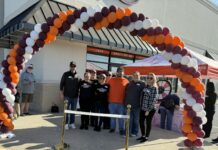AUBURN UNIVERSITY, Ala. – Halloween season starts in July, at least according to gardening standards. For those wanting to grow their own pumpkins for spooky jack-o’-lanterns or festive fall centerpieces, early to mid-July is the time to get those pumpkin seeds in the ground.
Getting started
Bethany O’Rear, an Alabama Cooperative Extension System home grounds, gardens and home pests regional agent, said the cultivar a gardener decides to plant depends on the intended use for the pumpkins.
“There are certain pumpkin cultivars that are better suited for uses such as carving or making pies,” O’Rear said. “There are also many novelty cultivars that are great to decorate with, such as ‘Cinderella’ and warty pumpkins. In addition to traditional orange pumpkins, there are some cultivars that produce some pretty unique colors, including green, yellow, tan, red, white and even blue.”
When buying seeds, look for the days to harvest listed on the package. The following are some common pumpkin cultivars:
- Miniature: “Baby Boo,” “Bumpkin,” “Jack-Be-Little,” “Munchkin” and “WeeeeOne”
- Small: “Baby Moon,” “Darling,” “Iron Man,” “Little Giant and “Small Sugar”
- Medium: “Autumn Gold,” “Goosebumps II,” “Hijinks,” “Orange Bulldog” and “Rouge Vif D’Etampes”
- Large: “Cinderella,” “Fairytale,” “Gold Medal,” “Magician” and “Sorcerer”
Other pumpkin cultivars can be found in the Extension Brief, “Managing a Pumpkin Crop.” Individuals interested in planting pumpkins can also contact the home grounds regional Extension agent in their area for information on a specific cultivar.
Planting and managing
Pumpkins are like any other vegetable crop. They need to be planted in an area that has well-drained soil. This is especially important for pumpkins, because the fruit makes direct contact with the ground. If the soil is constantly wet, the pumpkins will rot on the vine.
O’Rear said to try planting pumpkins on a raised soil area. In this case, gravity will help drain the water away from the plants. They also need to be planted in a spot that receives approximately six to eight hours of sunlight each day.
“Keep in mind that pumpkins are vining crops, so they are going to take up a lot of room,” O’Rear said. “You don’t necessarily have to have a giant garden plot, but just be mindful to choose a spot that gives the pumpkins room to grow.”
Pumpkins are in the Cucurbitaceae family, along with vegetables like cucumbers and squash. As a cucurbit, one of the biggest management issues related to pumpkins is fungal diseases. These can include downey mildew, powdery mildew, fusarium wilt and phytophthora.
“It is not impossible to grow pumpkins in an organic situation, but these fungal diseases make it very challenging,” O’Rear said. “Cultural practices, such as crop rotation, are very helpful in disease management. Also, it is very important to scout for symptoms, using fungicides when needed.”
A cultural practice is a change made in the growing environment. This includes things like changing planting dates, rotating crops, mowing and irrigating. Contact the home grounds regional agent in the county Extension office for control recommendations.
Harvesting
The harvesting timelines for pumpkins and winter squashes are different than other vegetables. For example, summer squashes are harvested while they are still immature. However, it is important to wait to harvest pumpkins and winter squashes until they are fully matured.
“After harvesting, it is recommended that the pumpkins go through a process called curing, which extends the lives of the pumpkins,” O’Rear said. “This process can also help heal wounds, ripen immature fruit and enhance color.”
To cure a pumpkin, store them at 80 to 85 degrees Fahrenheit in a place that has 75 to 80% relative humidity for 10 to 20 days. More information on harvesting and curing is available in the Alabama Extension publication, “Harvesting, Curing and Post Harvest Care of Pumpkins and Winter Squash.”




















